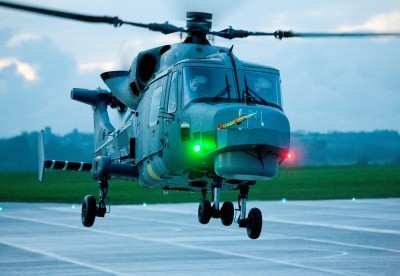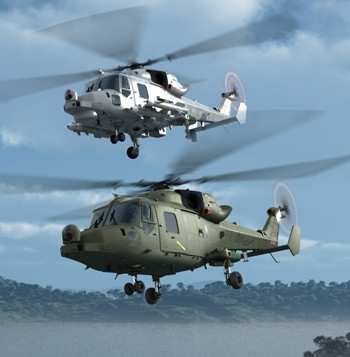Tue, Nov 23, 2010
Delivery Of Production Helicopters Expected In Late 2011
The third and final AW159 test aircraft successfully completed
its initial flight last Friday at AgustaWestland's Yeovil facility
in the UK. In a news release, AgustaWestland said the flight
involved a range of general handling checks, and the helicopter
performed as expected. The aircraft, designated TI3, is the third
of three test aircraft that will complete a 600 hour integrated
flight test program. This first flight comes just a few weeks after
the second AW159 (TI2) first flew. All the three aircraft flew
together for the first time Friday.

"This program will deliver unprecedented levels of capability
and cost/effectiveness to the services once the operational
readiness is achieved," said Graham Cole, Managing Director,
AgustaWestland.
Aircraft TI1 continues to perform air vehicle and flight
envelope testing while TI2 is undertaking the flight testing of the
aircraft's core and mission avionics systems, the systems and
software having already been developed and tested on
AgustaWestland's Full Systems Integration Rig (FSIR). TI3's main
task includes undertaking load survey trials and naval development,
including ship helicopter operating limit trials. AgustaWestland
has now also established a new AW159 production facility at its
Yeovil plant that introduces a pulse line production system to
bring significant efficiencies to the final assembly process. The
first production airframe was delivered to AgustaWestland by GKN
Aerospace in July 2010.

The first flight of the third AW159, known as the "Lynx Wildcat"
in UK military service, marks another step in the development of
this new six-ton multi-role military helicopter, 62 of which have
been ordered by the UK Ministry of Defence. The first aircraft will
be delivered at the end of 2011 with the aircraft becoming fully
operational with the Army in 2014 and the Royal Navy in 2015. The
British Army's AW159 Lynx Wildcat will perform a wide range of
tasks on the battlefield including reconnaissance, command and
control, transportation of troops and materiel, and the provision
of force protection. The Royal Navy variant will provide an agile
maritime capability providing anti-surface warfare capability and
force protection and will operate in support of amphibious
operations and be an important element in defending ships against
surface threats. There will be a high degree of commonality between
the Army and Royal Navy helicopters that will mean that an aircraft
can switch roles easily, principally through the changing of role
equipment.
More News
From 2014 (YouTube Version): One Of The Airshow World's Pre-Eminent Formation Teams Chats About The State Of The Industry At EAA AirVenture 2014, ANN News Editor Tom Patton gets th>[...]
Tactical Air Navigation (TACAN) An ultra-high frequency electronic rho-theta air navigation aid which provides suitably equipped aircraft a continuous indication of bearing and dis>[...]
Aero Linx: Doobert Hi, we're Chris & Rachael Roy, founders and owners of Doobert. Chris is a technology guy in his “day” job and used his experience to create Doobe>[...]
The Airplane Was Spinning In A Nose-Down Attitude Before It Impacted Terrain On June 20, 2025, at 0900 eastern daylight time, a Pitts Aerobatics S-2B, N79AV, was destroyed when it >[...]
Also: United Elite Sues, Newark ATC Transitions, Discovery Moves?, Textron @ KOSH The Commemorative Air Force Airbase Arizona is taking its “Flying Legends of Victory Tour&rd>[...]
 Classic Aero-TV: Up Close And Personal - The Aeroshell Aerobatic Team at Oshkosh
Classic Aero-TV: Up Close And Personal - The Aeroshell Aerobatic Team at Oshkosh ANN's Daily Aero-Term (07.13.25): Tactical Air Navigation (TACAN)
ANN's Daily Aero-Term (07.13.25): Tactical Air Navigation (TACAN) ANN's Daily Aero-Linx (07.13.25)
ANN's Daily Aero-Linx (07.13.25) NTSB Prelim: Pitts S2
NTSB Prelim: Pitts S2 Airborne 07.09.25: B-17 Sentimental Journey, Airport Scandal, NORAD Intercepts
Airborne 07.09.25: B-17 Sentimental Journey, Airport Scandal, NORAD Intercepts




